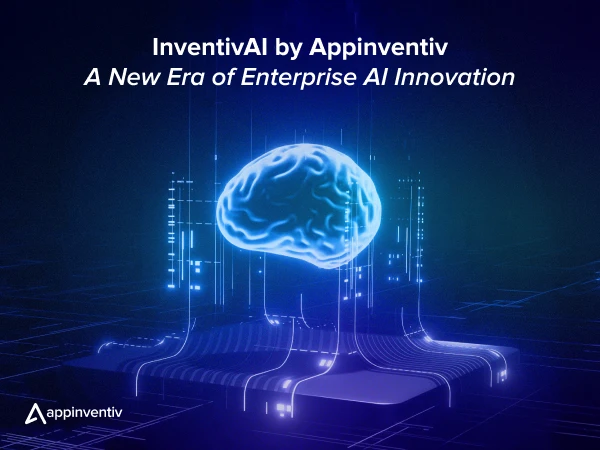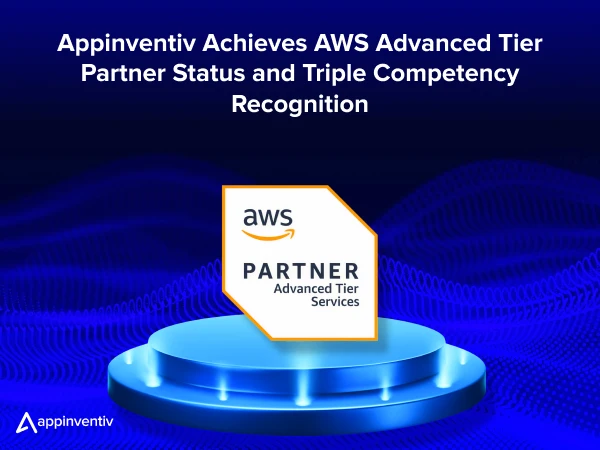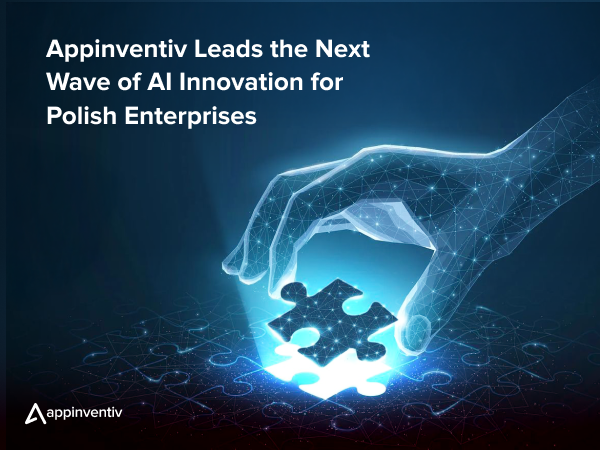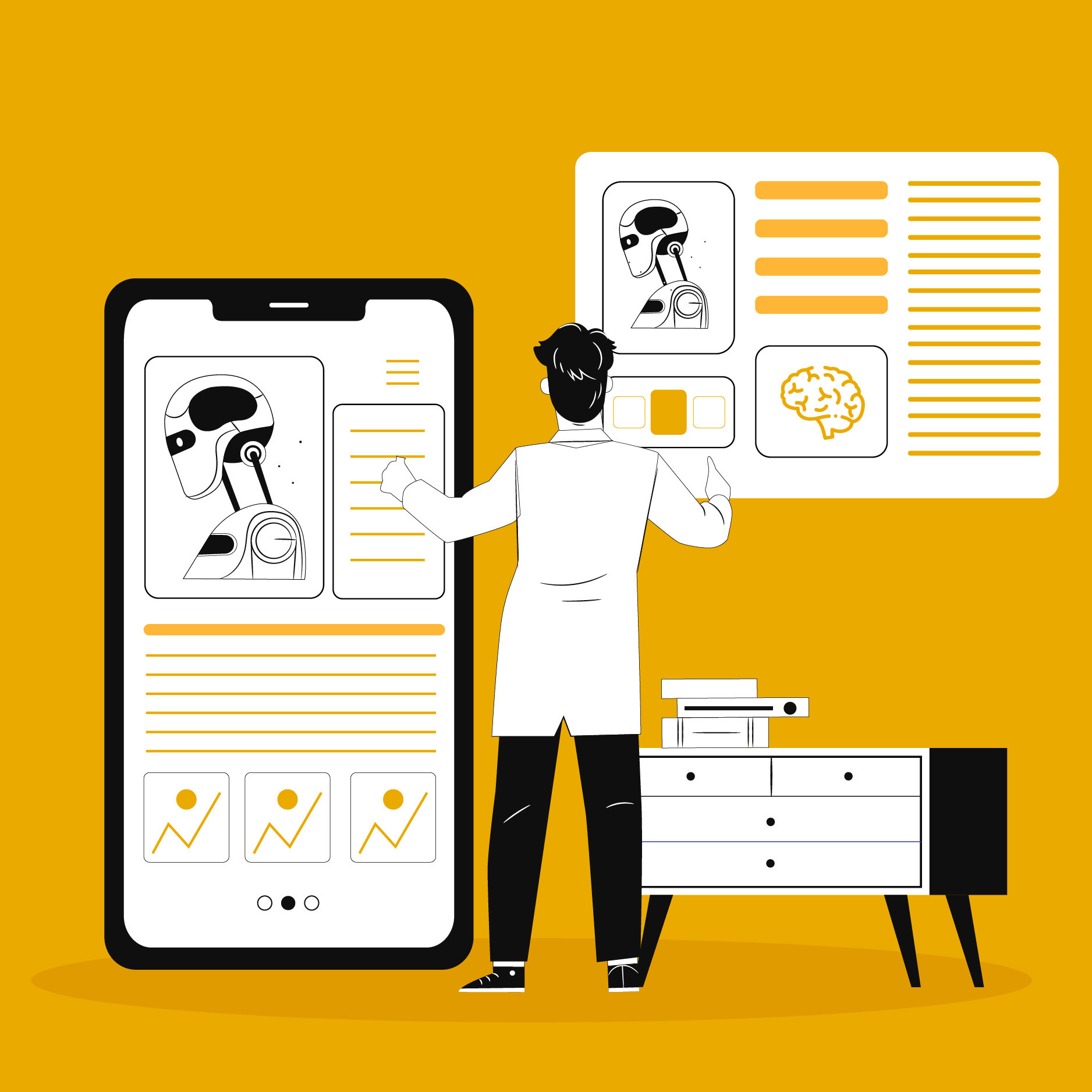- Clarifying Key Terms: Digitization, Digitalization, and Digital Transformation
- What is the Importance of Digital Transformation in Business: Applications and Advantages
- Increases Efficiency and Productivity
- Improves Customer Engagement
- Promotes Digital Culture
- Increases Business Revenue
- Better Resource Management
- Supporting Sustainability
- What Drives Digital Disruption and Transformation?
- Technical Innovations
- Customer Demands
- Ecosystem Changes
- Business Model Evolution
- Data Analytics
- Operational Processes
- Industry-Specific Use Cases & Benefits of Digital Transformation in Business
- Retail and eCommerce
- Healthcare
- Manufacturing
- Financial Services
- Logistics and Supply Chain
- Education (EdTech)
- Appinventiv’s Three-Step Digital Transformation Framework
- Step 1: Understand Industry-Specific Digital Disruption Opportunities
- Step 2: Create a Customer-Centric Business Strategy
- Step 3: Develop an Enterprise-Level Strategy Connecting Back, Middle, and Front Office
- Real World Digital Business Transformation Examples and Appinventiv’s Role in their DX Journey
- ERP Solution for IKEA
- End-to-End App Development for Adidas
- KFC Food Delivery App
- Edfundo – Financial Literacy App
- DiabeticU – Diabetes Management App
- Ility – Real Estate SaaS Platform
- Steps for Creating an Effective Digital Business Transformation Strategy
- Get Leaders and Employees on Board
- Establish New Business Processes
- Set Key Performance Indicators (KPIs)
- Choose Your Technology Wisely
- Allocate Time and Budget
- Outsource the Right Tech partner
- Post-Implementation Feedback
- Scale and Transform
- Myths and Facts on Digital Business Transformation
- What Are the Biggest Digital Transformation Challenges & How to Overcome Them?
- Lack of Proper IT skills
- Security Concerns
- Budget Constraints
- Organizational Culture
- How to Measure the ROI of Digital Business Transformation Efforts?
- Latest Trends of Digital Transformation for Business to Look Out for in 2025 and Beyond
- Hyper-Personalization
- Cloud Technology
- Blockchain Technology
- Augmented Reality (AR) & Virtual Reality (VR)
- 5G
- IoT and Edge Computing
- Hybrid Work Model
- Artificial Intelligence
- Cybersecurity
- Appinventiv: Your Trusted Tech Partner in Digital Transformation
- FAQs
Key takeaways:
- With 90% of global enterprises already adopting digital transformation, it’s clear that it’s essential for staying competitive.
- True transformation is a holistic blend of people, processes, and technology. It’s about reimagining your entire business to deliver seamless experiences and drive innovation.
- Digital transformation directly leads to increased efficiency, stronger customer engagement, and higher revenue.
- Success comes from a clear strategy: identify goals, get buy-in, establish new processes, set KPIs, choose the right tech, and partner with experts like Appinventiv.
When Satya Nadella took the reins at Microsoft, he famously declared that every business needed to become a software company. Nadella’s statement wasn’t just tech jargon—it was a wake-up call that reflects the broader trend of digital transformation.
Across industries, from retail and finance to manufacturing and logistics, companies are realizing that embracing digital transformation is no longer a competitive advantage but a dire necessity. They are increasingly leveraging cutting-edge technologies to innovate, improve, and expand.
According to the Harvard Business Review, approximately 90% of global enterprises are undergoing digital and AI transformation. By offering services digitally, organizations can effectively deliver the experiences their stakeholders and end-users expect. They can also expect to see growth in employee satisfaction, customer engagement, and business innovation.
This is why investments in digital business transformation have skyrocketed. According to a recent report, global spending on digital technologies is expected to surpass $3.289 billion by 2030, representing a significant increase from $911.2 billion in 2024, with an impressive annual growth rate of 23.9% (Source: MarketsAndMarkets).
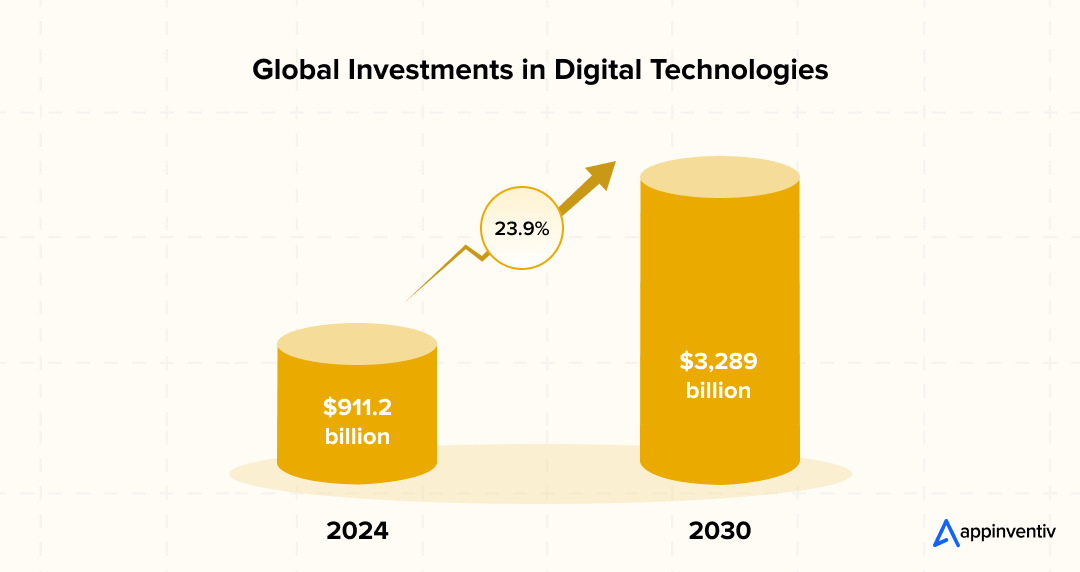
Many large brands, including Domino’s, Walmart, IKEA, and Amazon, have already implemented digital transformation methodologies in their operational processes. Now it’s your turn to go digital, if you haven’t already. If you’re unsure about how to initiate or accelerate your digital transformation journey, we’re here to help.
In this enterprise digital transformation guide, we will discuss the various aspects of digital transformation, including the key elements, failed stories, and steps for creating a digital transformation strategy. So, let’s get started.
Clarifying Key Terms: Digitization, Digitalization, and Digital Transformation
Before we dive deeper, it’s important to distinguish between three commonly confused concepts: Digitization, Digitalization, and Digital Transformation
- Digitization is the process of converting analog information into digital form, such as scanning paper documents.
- Digitalization involves utilizing digital technologies to enhance existing business processes, such as automating manual workflows.
- Digital Transformation is a holistic, organization-wide shift that integrates digital technology into every area of business, fundamentally changing how you operate and deliver value to customers.
What is the Importance of Digital Transformation in Business: Applications and Advantages
Digital transformation is far more than implementing new technology; it’s a fundamental reimagining of your entire business, from models and processes to how you engage with customers and stakeholders. Whether it’s automating workflows, adopting cloud platforms, or harnessing AI-driven insights, enterprises face both complex challenges and exciting opportunities on this journey.
This pervasive shift isn’t just a growing trend; it’s the bedrock of sustained success in today’s dynamic market. Digital transformation empowers businesses not only to meet but genuinely anticipate the evolving needs of their customers and other stakeholders. By embracing it, companies can operate more efficiently, operate faster, and compete more effectively.
On that note, here are the top benefits of digital transformation in business as you embark on your vital digital journey:
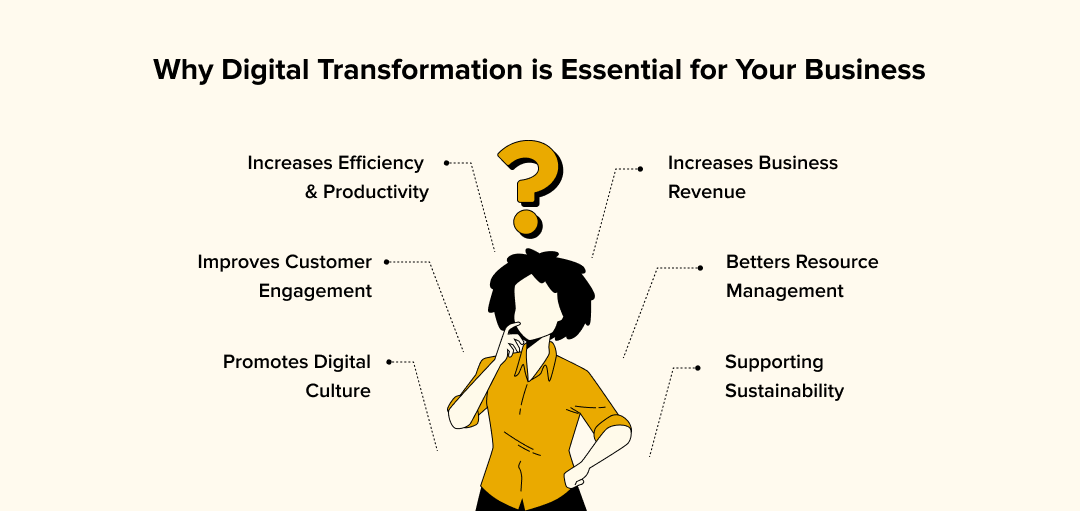
Increases Efficiency and Productivity
Digital technologies enhance efficiency and productivity by streamlining processes and accelerating operations. For instance, robotic process automation (RPA) can outperform humans, capable of completing tasks 20 times faster. Also, unlike humans, RPA typically doesn’t make errors.
Moreover, enterprise business intelligence and data analytics can collect and analyze data at a speed and accuracy that humans can never match. However, human workers can utilize that analysis to make data-driven decisions more quickly.
Improves Customer Engagement
Digital technologies allow businesses to collect, store, and analyze customer data to learn more about their customers’ preferences and needs. Companies can utilize technologies such as artificial intelligence, machine learning, and AI-driven analytics to gain deeper insights. This allows them to create products and services tailored to each customer’s unique preferences.
Promotes Digital Culture
By equipping employees with the right tools, digital transformation facilitates a culture of innovation and agility. While these tools provide a seamless way to collaborate, they also drive the organization forward on its digital journey. This digital culture shift is crucial for businesses to remain competitive and sustainable. It encourages continuous upskilling and digital fluency, empowering teams to capitalize on the benefits of transformation fully.
Increases Business Revenue
Digital transformation provides a roadmap to deal with uncertainty and changing customer expectations, resulting in higher revenue and reduced operational costs. According to the SAP Community, 80% of executives reported that their digital transformation efforts have increased profitability, while 85% experienced an increase in market share.
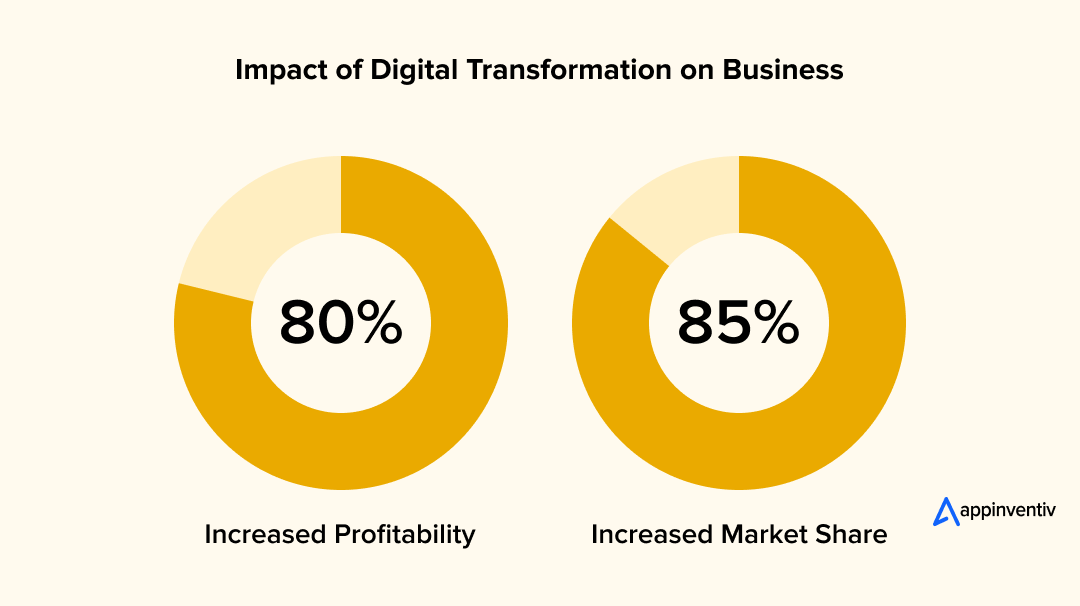
Better Resource Management
As companies transform, they replace legacy systems with modern IT architectures designed to consolidate processes and seamlessly enable data flow across all departments. This end-to-end digital technology approach helps executives and IT leaders eliminate duplicate and superfluous technologies. Additionally, it helps businesses to optimize the costs associated with digital transformation.
Moreover, software-as-a-service (SaaS) platforms and on-demand computing resources enable organizations to align their technology investments with actual usage, avoiding unnecessary expenses.
In addition to these benefits, digital transformation allows businesses to focus on various other operational areas and achieve broader strategic goals. Gartner’s 2025 report highlights these focus areas.
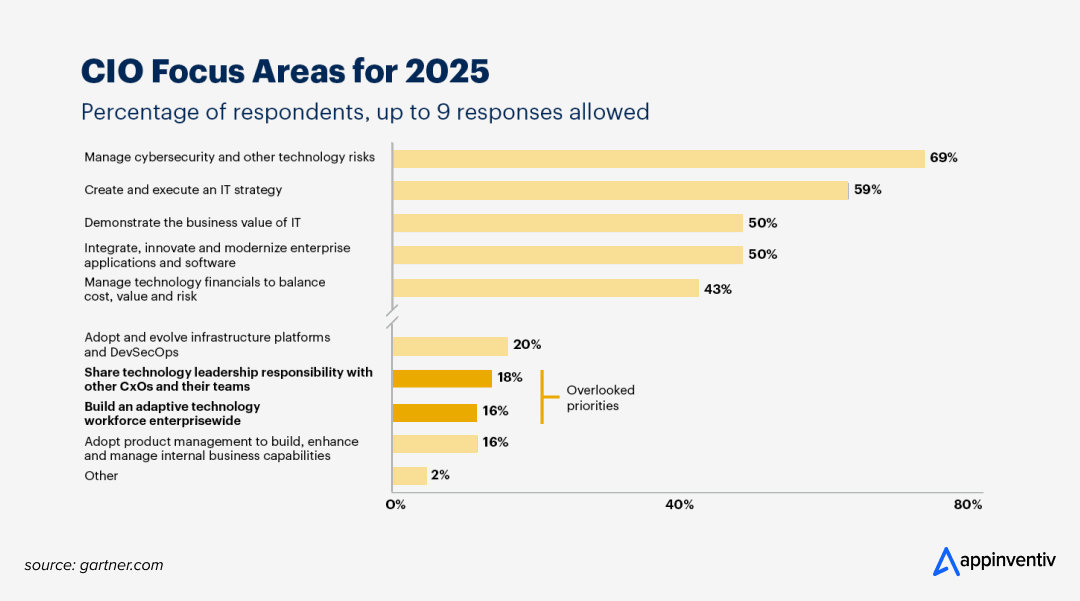
Supporting Sustainability
Modern digital transformation initiatives often contribute to sustainability goals, whether by reducing paper waste, optimizing energy use through smart systems, or enabling remote work to reduce commuting. As you plan your digital journey, consider how technology can help your organization operate more sustainably.
What Drives Digital Disruption and Transformation?
“There is no alternative to digital transformation. Visionary companies will carve out new strategic options for themselves — those that don’t adapt will fail.”;
– Jeff Bezos, Head of Amazon
Statements like these highlight that digital transformation is no longer an option, but an inevitable part of today’s uncertain and evolving marketplace, redefining your business around new possibilities. It is a paradigm shift that is here to stay, with bone-deep effects for all organizations across industries.
The major driver of digital transformation is the digital disruption caused by emerging technologies, including enterprise AI, data science, customer demands, new business models, and ecosystem changes. Let’s explore these key pillars of digital transformation in detail:
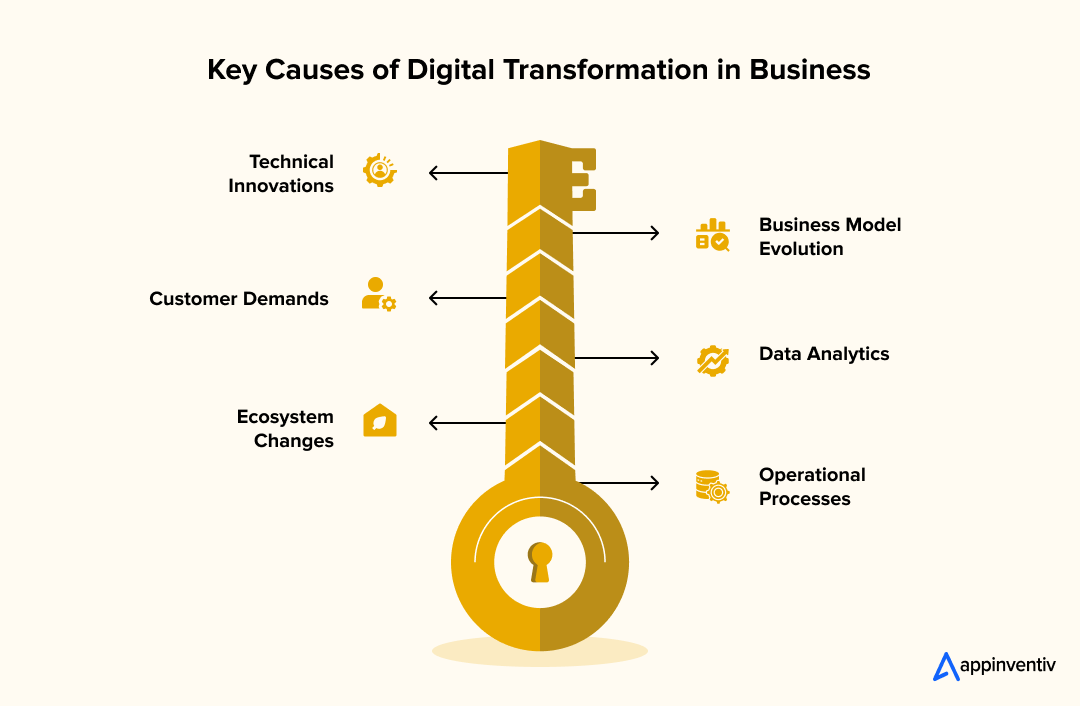
Technical Innovations
A series of technologies with obvious transformation abilities, like IoT, generative AI, and Blockchain, are the first cause of digital transformation for businesses. It is not only the advancements of these technologies but also their adoption by the government, businesses, and customers that drive transformation. These technologies introduce new capabilities, automate processes, and redefine how value is delivered, making them a foundational force behind enterprise digital transformation.
Also Read: The Impact of Deep Tech on Industries: A Comprehensive Analysis
Customer Demands
Customers’ needs and expectations are constantly evolving. These demands are fueled by technical innovations, societal changes, new trends, and various other factors. Today’s digitally empowered customers expect hyper-personalized services, real-time support, and seamless omnichannel experiences. These evolving customer expectations push businesses to adopt digital strategies that enhance engagement, satisfaction, and loyalty.
Ecosystem Changes
Companies are a part of much broader ecosystems. Changes in these ecosystems, whether regulatory updates, global crises, or shifts in the supply chain, can create immediate pressure for transformation.
For instance, the COVID-19 pandemic compelled companies to accelerate their digitization efforts across customer interactions, operations, and service delivery. To stay relevant, businesses must adapt to these disruptions with agile, technology-driven responses.
Business Model Evolution
The evolution of new business models is a crucial driver of digital transformation. Many traditional enterprises are transitioning to digital-first platforms, redefining how they deliver products and services. This shift enables businesses to meet modern customer expectations, streamline operations, and explore new revenue streams by introducing digital-centric offerings alongside their core services. From AI-driven telemedicine in healthcare to digital banking in finance, digital transformation for business ensures agility, relevance, and long-term growth in a rapidly changing market.
Data Analytics
One of the main reasons for adopting digital transformation for enterprises is to eliminate the pain points of your employees and customers. But how will you identify these pain points? Data integration and analysis can help identify them. Often, businesses fail to analyze their data when creating a digital business transformation strategy. This is not the right way to work.
If you don’t analyze data, you may miss out on the loopholes that your customers have to deal with regularly. Data-driven insights can help your team identify the pain points, identify gaps, understand user behavior, and implement impactful solutions. This strengthens the digital transformation roadmap and ensures that strategies are grounded in real-world evidence.
Operational Processes
Traditional operational processes are a fundamental driver of business digital transformation. By digitizing workflows, enterprises reduce the time, effort, and resources required to manage day-to-day operations and drive innovation. For instance, many companies have implemented robotic process automation to streamline their back-office processes, including those in legal and accounting.
Organizations that equip their workforce with digital tools and cloud-based platforms can enhance real-time collaboration, agility, and productivity. At the same time, they can also automate key functions through intelligent systems that capture and analyze data seamlessly.
Industry-Specific Use Cases & Benefits of Digital Transformation in Business
So far, you would have understood that business digital transformation is not just a buzzword; it’s a tailor-made suit essential for every industry, fitting their unique challenges and ambitions. Let’s examine how different sectors can leverage digital transformation in business to drive innovation, scale, and growth.
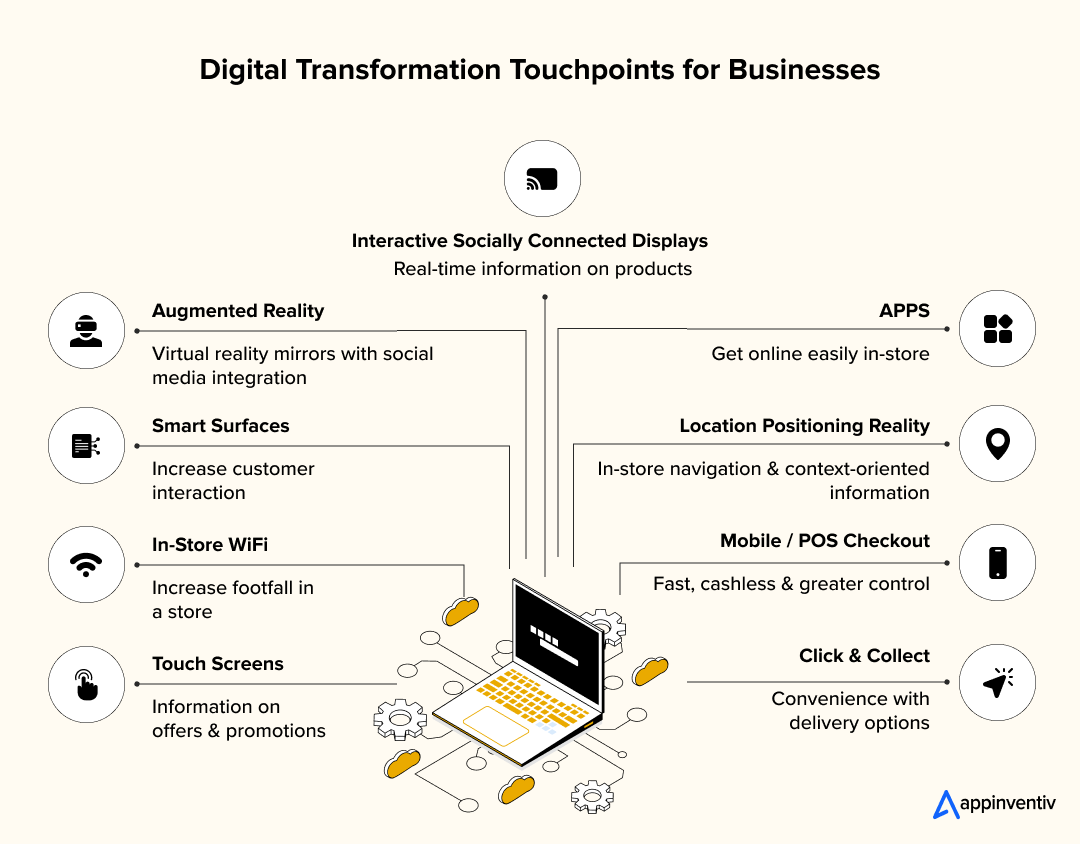
Retail and eCommerce
In the hyper-competitive retail world, it’s all about delighting customers and streamlining operations. Digital business transformation helps companies create seamless shopping experiences that keep customers coming back for more.
- Anticipate Customer Desires: Retailers use AI to offer hyper-personalized recommendations, as 71% of consumers expect personalized interactions. (McKinsey & Company).
- Bring Stores to Life: AR/VR in retail enables shoppers to virtually “try on” products or visualize furnishing items in their homes, bridging the gap between online and physical stores.
- Smart Operations: AI-driven systems automate inventory and adjust prices in real-time, boosting sales and cutting waste.
Healthcare
Digital transformation is revolutionizing healthcare, making patient care more personal, efficient, and accessible than ever before. It’s about empowering caregivers and improving outcomes.
- Personalized Healing: AI helps tailor treatments based on individual patient data, making healthcare more precise and effective.
- Care From Anywhere: AI-driven telemedicine solutions and wearable tech enable remote patient monitoring, crucial for reducing hospital readmissions and improving ongoing care.
- Secure Data Sharing: Blockchain technology in healthcare systems ensures patient records are secure and shared transparently, enhancing privacy and trust.
Manufacturing
Welcome to Industry 5.0, which is transforming the manufacturing industry like never before! This connects every piece of the manufacturing puzzle, leading to smarter factories, higher-quality products, and incredible adaptability.
- Machines That Predict: IoT sensors on equipment, combined with AI, predict when a machine needs fixing before it breaks down, saving massive amounts of time and money.
- Virtual Factories: “Digital Twins” in manufacturing create virtual replicas of entire factory floors or complex machinery. This allows teams to test changes and optimize production without halting operations.
- Flawless Quality: AI-powered visual inspection systems can spot tiny defects that humans might miss, ensuring every product is perfect.
Financial Services
Digital transformation in FinTech is all about making services more customer-friendly, incredibly secure, and highly efficient, all while navigating strict regulations.
- Your Personal Financial Assistant: AI-driven chatbots and virtual assistants handle customer inquiries and offer personalized financial insights.
- Bulletproof Security: Advanced AI and machine learning are constantly analyzing transactions to detect and prevent fraud in real-time.
- Instant Onboarding: Robotic Process Automation (RPA) speeds up back-office tasks and makes joining a bank or applying for a loan incredibly fast and easy for customers.
Logistics and Supply Chain
For logistics, digital transformation means gaining incredible visibility, efficiency, and resilience across complex global supply chains. It is about knowing exactly where everything is, all the time.
- Real-Time Tracking: IoT sensors provide live updates on shipments and assets, giving you complete transparency from the moment an item leaves the factory until it arrives.
- Smarter Forecasting: AI in the logistics industry analyzes market trends and historical data to predict demand accurately, optimizing inventory levels and preventing costly stockouts or surpluses.
- Transparent Journeys: Blockchain technology creates an unchangeable record of every step in the supply chain, building trust and making it incredibly easy to trace products.
Education (EdTech)
Digital transformation in education is creating more engaging, accessible, and personalized learning environments. It is about empowering both students and educators with cutting-edge tools.
- Personalized Learning Paths: AI-driven platforms in education adapt content to each student’s pace and style, leading to better outcomes and more engaging learning.
- Immersive Learning: AR/VR offers engaging, hands-on experiences that transform the way complex subjects are taught through virtual labs or field trips.
- Automated Admin: Digital tools streamline administrative tasks like scheduling and grading, freeing up educators to focus more on teaching and student engagement.
Now that you understand the ins and outs of digital business transformation, let’s examine the three-step framework that our team follows and how we can be your trusted tech partner in the digital journey.
Appinventiv’s Three-Step Digital Transformation Framework
Our digital transformation roadmap provides business leaders a clear starting point, a practical checklist, and a sequenced action plan. What sets our framework apart from others is its focus on:
- Helping executives grasp the bigger strategic picture
- Breaking down concepts into concrete tasks and sequences
- Driving transformation across both back and front offices
- Customizing solutions to meet each business’s unique needs
Step 1: Understand Industry-Specific Digital Disruption Opportunities
Digital business transformation solutions have varying impacts on different industries. Although it creates opportunities that enable businesses to adopt alternative business models, every sector requires a unique approach to transformation.
While we promote technological innovations such as AI-powered mobile app development, IoT, and blockchain, the application of these technologies varies significantly across different industries. For instance:
- Manufacturing leverages Industrial IoT for optimizing its supply chain.
- Healthcare uses AI technology to improve access and patient care
- The banking sector utilizes blockchain technology to transcend geographic boundaries and facilitate secure, transparent, and cross-border transactions.
- Fintech applies digital transformation to detect and prevent fraud.
Our digital transformation services begin by identifying the unique challenges specific to each industry and finding use cases for disruptive technologies to address those challenges.

Step 2: Create a Customer-Centric Business Strategy
Successful digital transformation efforts begin with customers. When we talk about putting customers first, we make businesses understand how modern customers leverage technology and abundant information to compare, shop, and share.
We help businesses engage customers on their preferred platforms, equipping them with technologies customers use daily. We build frameworks to capture, analyze, and act on customer insights in real-time.
Importantly, we help businesses find the balance between over-delivering customer value and managing associated costs, ensuring agility in meeting rapidly evolving customer needs.

Step 3: Develop an Enterprise-Level Strategy Connecting Back, Middle, and Front Office
Appinventiv professionals strongly believe that to realize the full potential of digital transformation, it is important to not just add it to platforms that act as customer touchpoints but also to the supply chain, IT, operations, finance, and human resources.
- Front office: We identify products, services, and models that don’t enhance customer experience. We integrate AI-driven analytics and real-time data capture to anticipate customer behavior and personalize offerings.
- Middle office: We enhance employee experience by developing enterprise software that improves connectivity, transparency, and agility, and reduces friction.
- Back office: Our focus is on automating workflows, modernizing or replacing legacy systems, and building scalable cloud-based IT infrastructure. We emphasize delivering real-time data to support predictive and proactive business decisions.
In addition to these steps, we take measures to help our partners understand that digital transformation is an ongoing journey, not a one-time project.
Also Read: IT Strategy for Business: The Key to Digital Transformation
Real World Digital Business Transformation Examples and Appinventiv’s Role in their DX Journey
Digital transformation is no longer just a trend; it has become a necessity. It has now become essential for businesses to survive and thrive in the competitive landscape. As a leading digital transformation company, we have helped several brands worldwide to elevate their digital business transformation journey, tailored to their unique requirements.
Here are some real-world digital business transformation examples that our tech experts have delivered to the world’s major brands, showcasing how our unmatched excellence in delivering digital business transformation services can bring value to your business.
ERP Solution for IKEA
Challenge: Enhance in-store customer experience and product catalog browsing.
Solution: We developed an ERP solution for IKEA that allows walk-in customers to browse the store’s product catalogs right from the in-store tablet panel.
Result: Expanded to 7+ IKEA stores in the UAE. The retail outlet touts the solution as a major source of ROI measurement.
You might also want to explore ERP software development cost estimation for your business

End-to-End App Development for Adidas
Challenge: Create an engaging end-to-end shopping experience for Middle Eastern users.
Solution: We helped Adidas expand its mobile presence by developing a comprehensive eCommerce application using native Android and iOS frameworks.
Result: The app has been downloaded over 2 million times and helped Adidas acquire 500,000 new customers in the region.

KFC Food Delivery App
Challenge: Enhance the digital ordering and delivery experience for customers.
Solution: Appinventiv collaborated with KFC to develop a comprehensive food delivery application.
Result: Witnessed a 22% increase in conversion rate, achieved a 4.5 average rating across app stores, with over 50% of total orders coming through the app, and a 60% increase in repeat purchases. Over 30,000+ orders fulfilled per day via the app.

Edfundo – Financial Literacy App
Challenge: Create an engaging platform for financial literacy and money management.
Solution: We partnered with Edfundo to develop a robust financial literacy and money management application.
Result: Helped the client bag a pre-seed funding of $500,000 and prepare for a seed funding round of $3 million. Also secured partnerships with Visa and
DiabeticU – Diabetes Management App
Challenge: Provide a comprehensive, compliant tool for diabetes management and health tracking.
Solution: Appinventiv’s tech experts created DiabeticU, a user-friendly diabetes management application that focuses on usability and security, while integrating stringent HIPAA compliance requirements.
Result: Empowered users to monitor and manage their health conditions effectively.
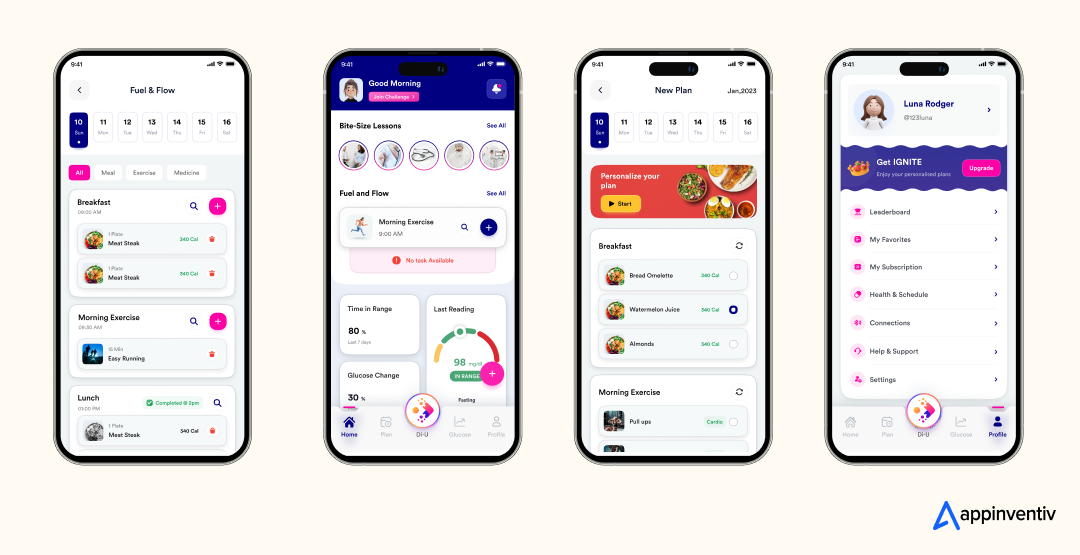
Ility – Real Estate SaaS Platform
Challenge: Develop a scalable SaaS platform to streamline commercial property portfolio management.
Solution: We built Ility, a comprehensive SaaS-based white-label real estate platform.
Result: Achieved 40% higher occupancy and a 2% increase in landlord ROI, along with automation across infrastructure and enhanced operational efficiency.
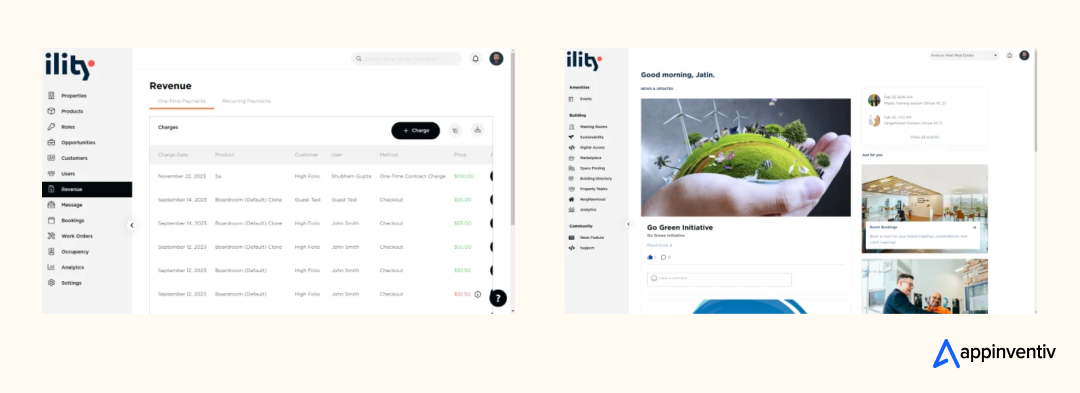
Well, these are just a few of our real-world digital business transformation examples. Check out our complete portfolio of success stories here.
Also Read: Why Appinventiv Stands Out as the Leading Tech Consulting Provider for Digital-First Enterprises
Steps for Creating an Effective Digital Business Transformation Strategy
Creating an effective enterprise digital transformation strategy requires more than adopting new technologies. It requires a clear vision, aligned goals, and a plan of action tailored to your organization’s unique needs. From redefining customer experiences to modernizing operations, each step plays a vital role in building a resilient, future-ready enterprise. Here are the steps to consider when implementing a digital business transformation strategy:
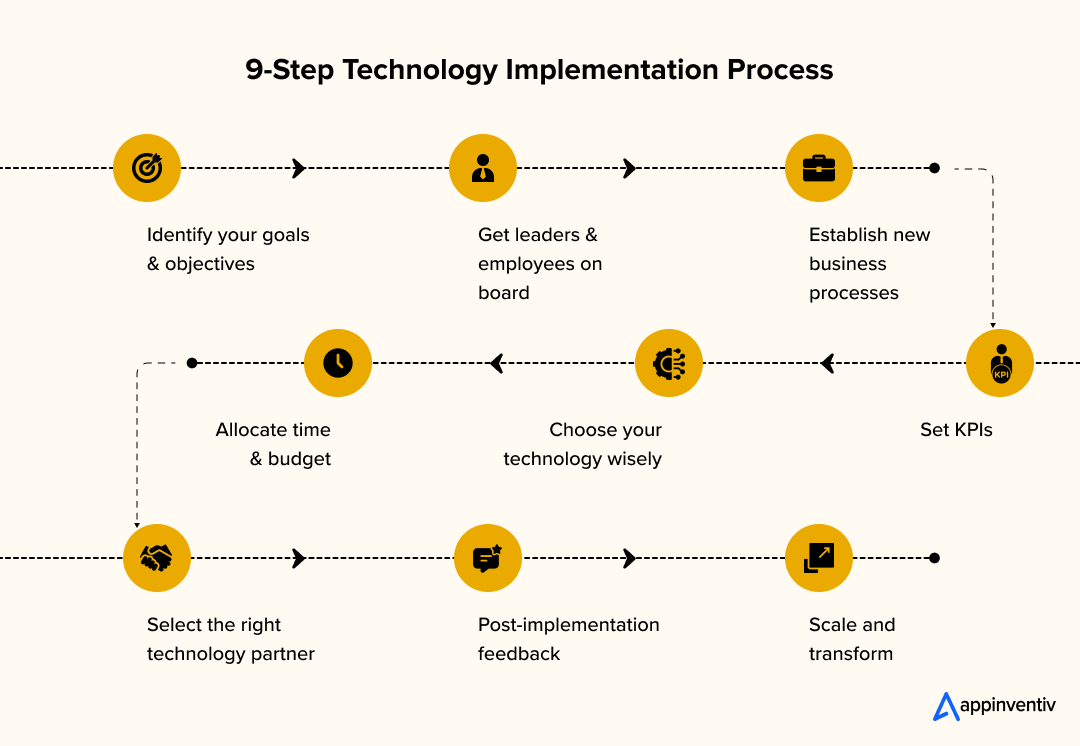
Identify Your Goals and Challenges
A digital business transformation strategy should clearly outline:
- What are your objectives?
- What steps are needed to achieve your goals?
The objectives and plans of action can vary for different organizations based on their unique challenges and requirements. However, here are some basic objectives every organization should consider:
- How can you increase customer engagement?
- Will adopting new technology and processes create a cost-effective and more efficient business model?
- What challenges are you facing within your organization, and how can business digital transformation help overcome them?
- Do you have processes in place to gather data and insight from analytics?
Answering these questions will help you identify areas within your plan that require immediate attention or which components of your strategy should be addressed first.
Get Leaders and Employees on Board
To ensure the success of your corporate digital transformation strategy, securing support from both leaders and employees is crucial. The first step is to secure strong executive sponsorship, as gaining buy-in from the C-suite makes it easier to initiate the digital transformation planning process.
Equally important is involving your employees early in the process. Listen to their challenges and identify how digital transformation can solve real pain points. If digital transformation in business can solve their problems, they will be more willing to be part of the process and even support your DX initiatives.
Make sure your employees understand what digital transformation is in business and why it matters for you. Host collaborative sessions with key stakeholders to align goals, clarify expectations, and surface potential roadblocks before implementation begins.
Establish New Business Processes
Your ‘business as usual’ approach may not match your corporate digital transformation initiative. Creating and adopting new processes can only help your organization succeed.
For some organizations, the digital transformation of business processes will require a complete overhaul. To organize this change, it’s critical to ensure that everyone, including employees and other stakeholders, understands the updates, knows who is accountable for what, and what systems are being implemented to support them.
Set Key Performance Indicators (KPIs)
The next step is to establish KPIs to measure success and track goals. You can start with objectives that your team cares about. For instance, IT teams can begin monitoring KPIs for a certain type of infrastructure. Service delivery and assurance teams can start by monitoring business activity trends and volumes. Furthermore, you can identify the best-case scenario, the worst-case scenario, and your expected outcome to help assess the success of your KPIs.
Setting the right KPIs and measuring their performance will help determine how well your business digital transformation efforts are going and what you need to improve.
Choose Your Technology Wisely
The success of your digital transformation hinges on choosing the right technologies. Thus, make sure to select the technologies that help scale your business, improve efficiency, and drive innovation. Ultimately, the technology you select should align with your digital business transformation goals and support long-term growth.
Allocate Time and Budget
Your strategy of digital transformation in business must be approached as a series of well-planned, strategic initiatives rather than a one-time effort. This requires dedicated time, budget, and clear ownership to ensure success. Hold regular meetings to address challenges, track progress, and keep communication transparent across teams.
Establish a defined budget for each phase of the transformation and assess its impact on business operations.
Outsource the Right Tech partner
To ensure the success of your DX plan for enterprises, it’s crucial to hire a trusted tech partner who understands the importance of digital transformation in business and has proven expertise in delivering digital business transformation services. The experts will help you implement changes, scale your business, and drive your digital transformation journey without any hassle.
Also Read: An Entrepreneur’s Guide on Outsourcing Digital Transformation
Post-Implementation Feedback
After you have implemented your digital business transformation plan, it is imperative to collect insights and measure success against defined goals.
Conduct surveys with employees, partners, and customers who are affected by the changes to understand their experiences and levels of adoption. Analyze external feedback to determine whether the enterprise digital transformation has delivered the intended value, and solicit stakeholder input on areas that could be improved. You can use these insights to fine-tune your strategy, address gaps, and enhance future transformation efforts.
Scale and Transform
By now, your company will begin to see results. Leverage this success to gain momentum and scale your business. There will always be changing customers’ needs and emerging technologies; consider them strategically and implement them as much as possible. This ongoing transformation strategy will help you stay competitive and sustainable in the ever-evolving digital landscape.
Myths and Facts on Digital Business Transformation
There are several popular myths surrounding enterprise digital transformation that can derail your strategic initiatives and dilute impact. Misconceptions about technology, scale, or outcomes often lead to unrealistic expectations and poor implementation. Let’s break down some of these myths with the facts that truly define successful digital transformation.
| Myth | Fact |
|---|---|
| Business transformation is all about technology | True transformation blends people, processes, and technology. It’s not just about tools. |
| You will have to launch a new product from scratch | Many digital efforts focus on enhancing existing offerings and operations, not reinventing them. |
| Digital transformation is a one-time project with a finish line | It’s an ongoing journey that evolves with your business and customer needs. |
| It’s just for large enterprises or tech companies | SMBs across various sectors are embracing digital technologies to enhance agility and efficiency. |
| Digital transformation guarantees instant ROI | Results take time—success depends on strategy, execution, and adaptability. |
What Are the Biggest Digital Transformation Challenges & How to Overcome Them?
While the business digital transformation roadmap presents unique opportunities for organizations to innovate and grow, it also comes with several challenges. From organization-wide resistance to change and the presence of legacy systems to uncertainty about what customers need, the list of challenges can go on and on. On that note, here are some of the common and biggest digital transformation challenges organizations face:
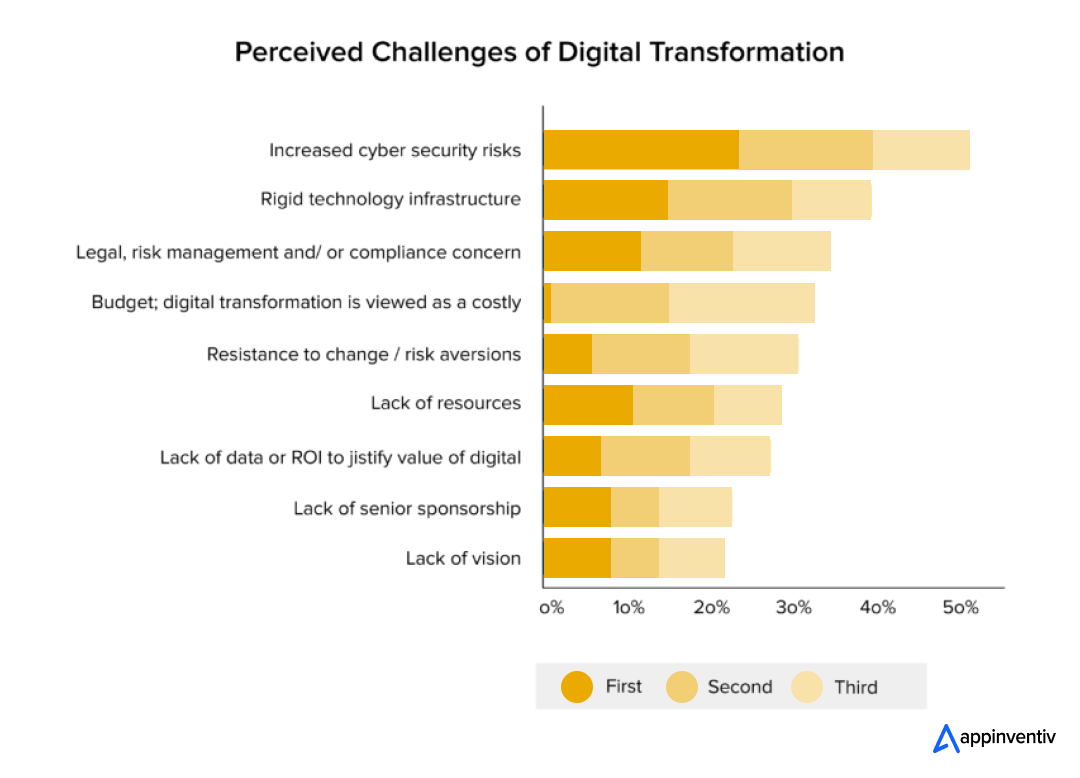
Lack of Proper IT skills
Challenge: To succeed in your corporate digital transformation efforts, you’ll need a skilled, high-performing IT team. This is particularly challenging to assemble, especially in the current tech worker shortage. According to a KPMG CIO Survey, 54% of organizations reported that they cannot achieve their digital transformation goals due to a lack of technically skilled employees.
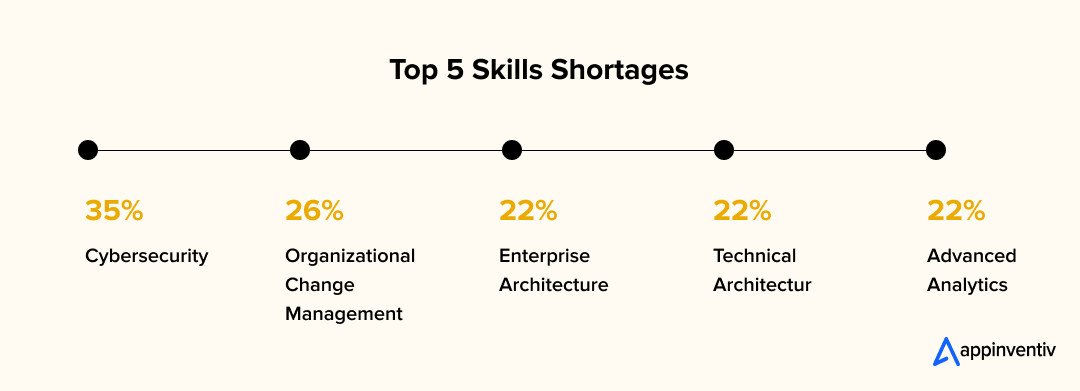
Solution: To overcome this serious challenge, organizations can hire reputed digital transformation experts. They will provide you with good guidance on your DX journey and bridge the implementation and migration gap.
Security Concerns
Challenge: One of the major concerns of today’s data-driven industries is security and privacy. Digital transformation often involves migrating from legacy systems to cloud environments and centralizing enterprise data. Although it is a beneficial step, it also increases the risks of cyber threats, such as data breaches, unauthorized access, and the loss of sensitive business or customer information.
Solution: To safeguard your digital infrastructure proactively, it is essential to implement a robust cybersecurity strategy, including real-time threat detection, encryption, and access controls.
Budget Constraints
Challenge: Digital transformation is a significant investment. For organizations with a poorly defined transformation roadmap, scope creep can gradually delay timelines and introduce unplanned tasks, ultimately inflating project costs.
Additionally, evolving customer needs and unforeseen IT errors can further escalate digital transformation expenses.
Solution: To manage budget constraints, develop a well-defined transformation roadmap with clear milestones, flexible timelines, and realistic cost projections. Prioritize initiatives based on ROI and adopt scalable, cloud-based solutions to optimize long-term expenses.
Organizational Culture
Challenge: Shortcomings in the organization’s culture are one of the biggest business transformation challenges. The most common misconception among business owners is that upgrading tools and technologies is sufficient to ensure digital success.
In reality, digital transformation is not just about technologies. It is also about your organization’s ability to adapt to these changes. Even with a well-planned strategy, governing organization-wide change can be one of the most prominent digital transformation problems. A lack of clear communication about the value and purpose of transformation efforts often results in employee resistance to change, hindering progress across departments.
Solution: To overcome cultural challenges, facilitate a change-ready mindset by aligning leadership, encouraging cross-functional collaboration, and investing in digital upskilling. Clear communication and inclusive involvement at every level can help build trust and ease resistance to transformation.
How to Measure the ROI of Digital Business Transformation Efforts?
Measuring ROI in digital transformation is challenging, but it is essential for sustaining investment. Traditional financial metrics often fall short because digital transformation is an ongoing, evolving process that impacts multiple facets of the business.
At Appinventiv, we recommend viewing digital transformation as a portfolio rather than a series of isolated projects. Here are some crucial steps you must take when measuring digital business transformation success:
- Set the initial level metrics before applying digital transformation changes to understand the starting point clearly.
- Use micro-metrics to track progress in an agile environment
- Incorporate key business outcomes such as customer lifetime value (LTV), time to market, operational efficiency, and cost-benefit analysis.
- Include customer experience metrics, like Net Promoter Score (NPS) or customer satisfaction (CSAT), to measure impact on end-users.
- Monitor adoption rates and employee engagement with new digital tools to assess organizational readiness and evaluate the success of change management.
- Evaluate long-term strategic benefits, such as market share growth or innovation pipeline strength, beyond short-term financial gains.
- Regularly reassess metrics to adapt measurement frameworks as transformation efforts evolve.
Latest Trends of Digital Transformation for Business to Look Out for in 2025 and Beyond
As technology continues to evolve at a rapid pace, digital transformation for small businesses and enterprises is reshaping the way businesses operate, interact, and grow. From 5G, Cloud, and AI integration to hyperautomation, the latest trends in digital transformation for businesses focus on building smarter, faster, and more resilient enterprises.
Let’s explore the key digital transformation trends set to define business innovation in 2025 and beyond.
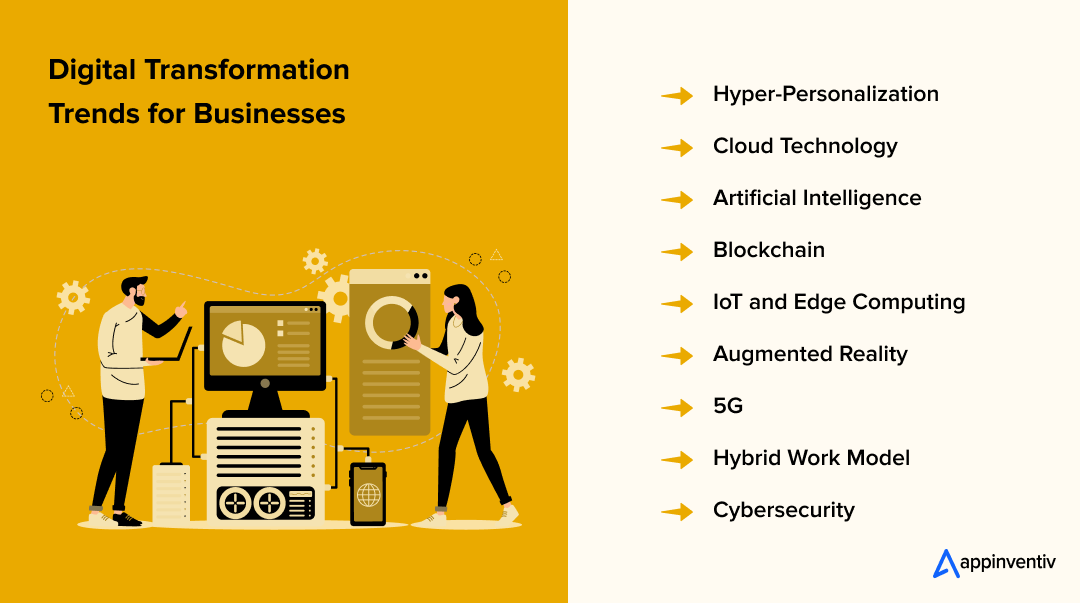
Hyper-Personalization
Forget one-size-fits-all! Today’s customers demand tailored experiences. A significant 71% of consumers expect personalization, and 76% get frustrated when they don’t receive it (Source: McKinsey & Company). We are now moving to “hyper-personalization,” where AI predicts and delivers exactly what your customers need, often before they even ask.
Cloud Technology
Cloud-based technologies are gaining popularity due to their exceptional benefits, including cost savings, scalability, and ease of use. Many organizations are migrating from traditional on-premises software to cloud-based solutions as they are more efficient and cost-effective ways to run business applications. Moreover, cloud computing for businesses offers enhanced cybersecurity features, protecting companies’ data.
Blockchain Technology
Blockchain is moving beyond cryptocurrency hype to become a cornerstone of enterprise digital transformation strategy. The technology helps enhance supply chain transparency, secure data in healthcare, and create more efficient cross-border transactions, with significant potential to streamline processes and reduce costs.
Augmented Reality (AR) & Virtual Reality (VR)
AR and VR are no longer just for gaming; they are revolutionizing businesses across various industries, enabling them to operate, train, and engage with customers more effectively. From virtual training simulations and remote assistance to immersive shopping experiences and product visualization, AR/VR is creating new possibilities and improving productivity.
5G
5G for mobile apps has become mainstream in 2025. This tech trend is expected to dramatically improve how services are delivered to users, thus transforming business operations and models. This network will provide lower latency, faster speeds, and a higher density than the 4G models.
IoT and Edge Computing
The physical and digital worlds are merging more deeply. With the IoT market expected to surpass 75 billion connected devices by the end of 2025, edge computing will process data instantly where it’s created, enabling real-time decisions (Source: NIST). This will indeed be the key to accelerating business digital transformation worldwide.
Hybrid Work Model
Hybrid work environments are the most common enterprise digital transformation trend in 2025 and beyond. They are rapidly growing, and workplaces are evolving. Companies are expected to deliver and adapt digitally connected experiences to increase efficiency and retain talent.
According to Accenture’s recent report, 63% of companies have already adopted a ‘productivity anywhere’ model. The onus is on employers to ensure that their workforce is equipped with proper resources and support to be successful.
Artificial Intelligence
Artificial intelligence is becoming an essential part of everyday life. By developing and leveraging AI-based platforms, you can forecast trends, make decisions, learn, and improve. Whether it is a startup or a large corporation, every company is trying to incorporate AI into its processes to enhance customer experience.
According to PwC estimates, AI is expected to contribute $15.7 trillion to the global economy by 2030, underscoring its foundational role in future economic growth. This immense AI potential is driving its widespread adoption and accelerating digital transformation among enterprises worldwide.
Cybersecurity
Cybersecurity is no longer just an IT problem; it is a critical business asset. A growing number of business leaders now view cybersecurity as a business risk, making cyber resilience a top priority for their organizations. This enables them to leverage AI in cybersecurity and adopt a “Zero Trust” architecture to keep vital data secure.
Appinventiv: Your Trusted Tech Partner in Digital Transformation
Digital transformation is not just a trend; it is how businesses survive and thrive today. As you have seen, staying ahead means embracing the latest technological innovation like AI, cloud, AR/VR, and the trustworthiness of blockchain.
However, navigating this complex future demands more than just technology; it requires expert partnership. Appinventiv stands ready with a skilled team of 1600+ enterprise digital transformation experts and mastery of cutting-edge tech.
In our 10+ years of experience in the industry, we have delivered over 3000 successful projects for many leading brands worldwide.
So, why wait? Keep pace with the digital business transformation trend with Appinventiv. Partner with us now to unlock your enterprise’s full digital potential.
FAQs
Q. What is Digital Transformation (DX)?
A. Digital transformation is the integration of digital technology in every business area, fundamentally changing how businesses operate and deliver value to customers. When we look deeper inside, the achievement of digital transformation goals can be seen as a cultural change that makes businesses sometimes even let go of the business practices that they had been following traditionally, in order to welcome new-age practices.
Q. What is the estimated cost of digital transformation for businesses?
A. The cost of digital transformation is not a fixed price tag; it is a strategic investment that varies widely. Digital transformation for small businesses can be covered within $50,000, while for large enterprises, an average transformation can cost around $500,000. However, this digital transformation cost can fluctuate greatly.
Key factors driving the cost include your company’s size and complexity, the scope of the transformation (a single system upgrade or an entire business overhaul), the state of your existing IT infrastructure, the specific technologies you implement, etc.
Remember, digital business transformation is an ongoing journey with continuous maintenance costs. Discuss your DX requirements with us to get a more precise estimate for your project.
Q. Why is digital transformation essential for business growth?
A. Digital transformation is crucial for business growth because it directly enables:
- Meeting Customer Expectations: Providing seamless, personalized experiences that customers now demand.
- Boosting Efficiency: Streamlining operations, reducing costs, and increasing productivity.
- Fostering Innovation: Creating new products, services, and agile business models to stay competitive.
- Data-Driven Decisions: Leveraging insights for smarter strategies and better outcomes.
- Building Resilience: Future-proofing your business to adapt and thrive amidst market changes.


- In just 2 mins you will get a response
- Your idea is 100% protected by our Non Disclosure Agreement.

Every successful business today shares one common thread: they've mastered the art of meeting customers where they spend their time. And increasingly, that place is iOS devices. While many companies are still debating whether mobile apps are worth the investment, smart businesses are already reaping the rewards of iOS mobile app development.

What began as a small collection of utilities and games has now become a cornerstone of digital life, powering everything from entertainment and social interaction to finance, healthcare, retail, and enterprise productivity. Just over 15 years ago, the mobile app economy was little more than a promising idea. A handful of apps, basic user experiences,…

In March 2020, when the world came to a standstill due to COVID-19, telemedicine use among physicians skyrocketed from 15.4% in 2019 to 86.5% in 2021. This dramatic shift wasn't just a temporary pandemic response—it fundamentally changed how we think about healthcare delivery.
















